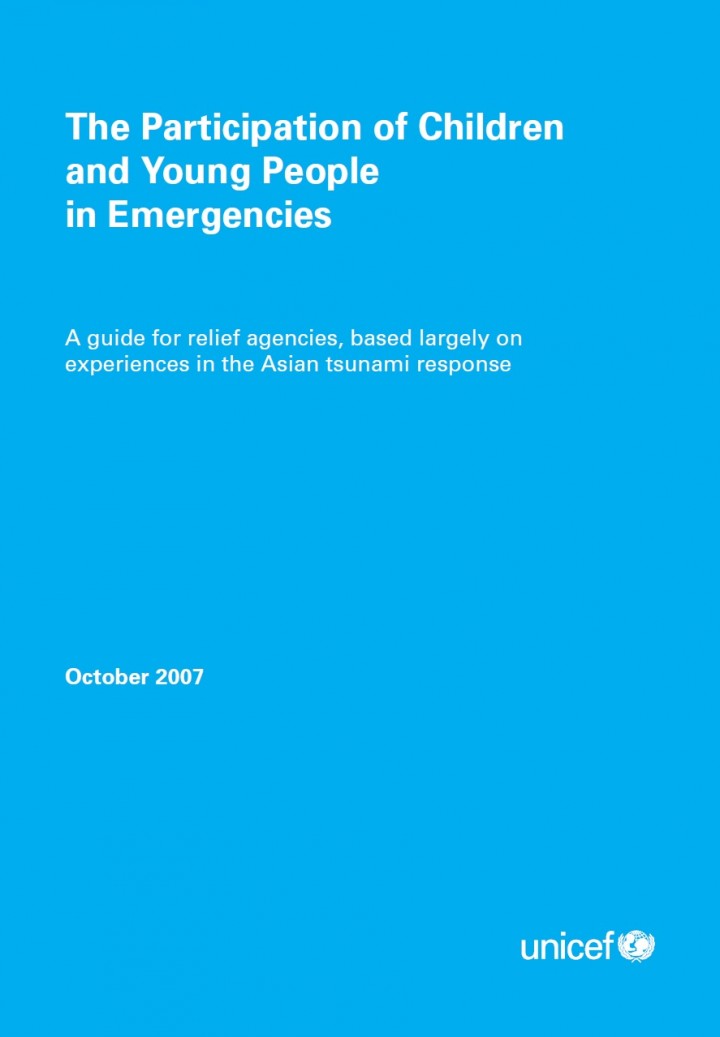The Participation of Young People and Children in Emergencies - A Guide for Relief Agencies, Based Largely on Experiences in the Asian Tsunami Response
UNICEF East Asia and Pacific Regional Office (2007)

Published in: 2007
Pages: 98
Publisher:
UNICEF East Asia and Pacific Regional Office
Author:
UNICEF East Asia and Pacific Regional Office
Uploaded by:
SuSanA Admin
Partner profile:
common upload
889 Views
6 Downloads
Introduction
Purpose and rationale
Children have made significant and valuable contributions in emergency situations. They have taken on roles and responsibilities and they have taken action – including life-saving decisions. They have responded spontaneously and taken part in planned relief and recovery action. This has included them in protecting lives, providing health care, distributing relief, caring for children and adults, and offering a hand in psychosocial support, health and hygiene education, reconstruction, planning and evaluating emergency relief work. The activities and achievements of children in emergencies demonstrate why their participation is of value to them, their families and their communities as well as to relief and recovery work. Yet their efforts have been little recognized. This guide provides a short account of what children and young people have done and can do in emergencies. It shows why and suggests how relief agencies should engage with children before, during and after emergencies. The main reasons for engaging with children and young people lie within the standards that relief agencies have set for themselves for the work they do. These standards aim for an accountability to communities that implicitly, at least, includes children and young people. The question, then, is how to actually implement them in practice for children and young people. A better understanding of the roles and responsibilities of children in disasters is long overdue.
Increased recognition among emergency specialists that “women and children are largely untapped resources in disaster response” (Florida, 2000) has led to an increased focus on gender issues in emergencies and particularly the impact on women’s lives. But the grouping of children together with women, with its implied emphasis on young children, has helped obscure children’s potential and actual participation. The Convention on the Rights of the Child (CRC) defines children as younger than 18; other definitions categorize adolescents as aged 10-19 and young people as aged 15-24. Within these age ranges, there are many mothers (and fathers). Although children and young people have less social (and often physical) power, their contributions in emergencies are significant and crucial to the survival of their families and communities. This guide is part advocacy document to promote children’s participation and part programme guide. It is not a tool kit. Working with children and supporting their participation requires experience and adherence to certain principles and standards. Relief agencies planning to involve children in their work will require specialist support from other agencies and individuals who
have practical experience working with children. For relief agencies, the first step in fulfilling their obligations is understanding that children and young people can participate in disaster-related activities, recognizing the importance of their participation and then making a commitment to involve them: Part One of this guide provides
examples of children’s participation and its effect. Following on from their commitment, relief agencies need to develop an ongoing practice of involving children: Part Two of this guide provides a starting point, with suggested areas for work.
Bibliographic information
UNICEF East Asia and Pacific Regional Office (2007). The Participation of Young People and Children in Emergencies - A Guide for Relief Agencies, Based Largely on Experiences in the Asian Tsunami Response. UNICEF East Asia and Pacific Regional Office
Filter tags
English Guidelines and manuals














